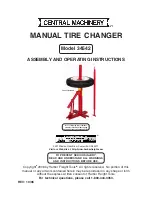
· 4 ·
REF. 53673
INSTRUCTION MANUAL
EN
DESCRIPTION
The liquid polymer headlamp refurbishment kit
is an innovative system for restoring sunburnt
headlamps to their original condition, with the
original gloss and a perfect finish in a very fast
and economical way.
SAFETY
While using, a mask must be worn to prevent
direct inhalation of the product.
DO NOT smoke while using.
Keep children, pregnant women and elderly
away while using.
Do not ingest it.
USE
The product should not be exposed to the sun
Restoration work should be done in a closed or
shaded area.
Cleaning
Clean the surface of the headlamps with a clean
cloth.
Insulation
Insulate with tape to limit areas and not damage
the paint.
Sanding process
The sanding must be done rigorously and the
surface of the optics must be sanded in a com-
pletely uniform way, only then can a perfect final
finish be achieved.
The sanding process can be done in two ways:
manual sanding or machine sanding.
Levels of sandpaper grain to be used depending
on the damage of the headlights to be repaired,
and phases of sanding:
• P150 - P180 for headlamps that have been
previously varnished.
• P240 for severely damaged headlamps.
• P320 for the elimination of the risk given by
P240.
• P500 for the elimination of the risk given by
P320.
• P800 for the elimination of the risk given by
P500.
• P1000 for the elimination of the risk given
by P800.
• P1200 for the elimination of the risk given
by P1000.
It is not mandatory, but if you want to make a su-
blime finish you must end the sanding process
with grain P1500 to P2000. The equipment in-
corporates sandpapers of 600, 1000, 1500 and
2000.
Manual sanding
In the manual sanding process, water sandpa-
per should be used. It is recommended that
when using this process, the direction of the
movement has to be changed when changing
to a new grain.
For example: (P180) sanding with transverse
movements, the next sandpaper (P240) must
be used with vertical movements, except for the
edges which must be carefully sanded to avoid
damage.
Once the sanding process is finished, the mois
-
ture on the optical surface must be dried with a
paper towel. The surface of the optics must look
uniform and smooth, white in colour and without
sanding marks. The optics are thus ready for
repair.
Machine sanding
For machine sanding, the use of abrasive discs
without holes is recommended. The discs with
holes can leave micro scratches and thus not
allow such a perfect finish. Corner areas may
have to be sanded manually to avoid the risk of
damage to friezes or paint.
Finishing
After the sanding process, the finish must be
done with the vaporization system that gives the
optics a perfect finish.
Apply from 60ml to 80ml of the product for the fi
-
nish in the glass, if you place more product there
is no problem because the surplus can be used.
However, you must guarantee an adequate ini-
tial dose so that you can do all the work at once.
Connect the equipment to heat the product and
wait about three minutes. Take the glass by the





































